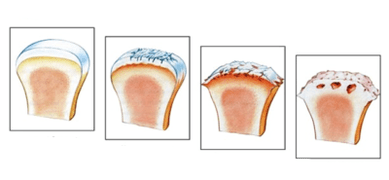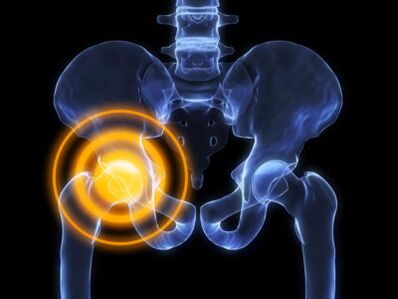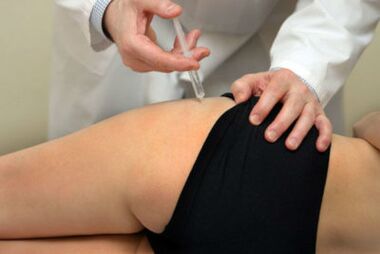Hip joint arthrosis is a complex disease with specific symptoms and complex treatment.The disease occurs in the background of metabolic disorders in the cartilage tissue of the joint cavity and the femur.
Hip joint or coksartrosis arthrosis is more common in elderly.It is generally accepted that the inflammatory reaction plays the main role in the pathogenesis of the disease.After numerous studies, arthrosis has been found to result in diseases associated with atherosclerosis and metabolic disorders.
The essence of illness
Coksartrosis is a disease based on metabolic disorders with atrophic and degenerative changes in the cartilage tissue of the hip joint.
It cannot be confused with arthritis.Unlike arthrosis arthrosis, non -infectious (aseptic) inflammation occurs, which develops and develops for years.
Pathogenesis of development:
- Violation of metabolic processes in the cartilage.The cartilage tissue diffusion obtains nutrients.It leads to the lack of inflammation or edema trace elements and minerals.
- In the background of nutrient damage, atrophic changes begin, the cartilage tissue is sophisticated, the amount of joint fluid and the quantity of condoms decreases.
- Due to the madness and destruction of the cartilage, severe pain begins and the amplitude of the joint movements is reduced.
- The cartilage tissue is very sophisticated, the fabulous gap narrows, and joint dystrophy occurs.
It does not happen until the beginning of dystrophy for more than a year.The disease can only be stopped in the first phase, with the development of the third stage of osteoarthrosis, the purpose of treatment is to reduce symptoms and to adjust the patient's life, an alternative to drugs - endoprostics.
Reasons

The disease is polyetiological, many conditions and factors that can lead to arthrosis or provoke its progression.If the causes of the arthrosis of the hip joint are not detected, such a disease is called idiopathic arthrosis.
The disease is not hereditary, but the genetic pathologies in which cartilage dysplasia occur can cause arthrosis of the hip joint.
Coksartrosis can also be caused by such diseases:
- Pertes syndrome - a characteristic sign of the disease is a breach of nutrients in the cartilage tissue and the femur head.It occurs in childhood, especially the boys are sick.
- Congenital dislocations and subluxation of the femur.During the injury, inflammatory reaction and aseptic melting of the cartilage tissue may occur.
- To the head of the femur.It is due to damage to the upper artery, which is secured to the top of the head.
- Rheumatoid and juvenile arthritis.Based on the effects of toxins or their own antibodies, exudative inflammation develops in the joint.
Given the fact that the disease progresses slowly, the disease may be on one side of the two and two.
Many factors contribute to the occurrence of arthrosis, including:
- spinal diseases (kyphosis, lordosis, skoliosis);
- Metabolic disease of the connective tissue;
- violation of the joints of the joint;
- Large blood vessels atherosclerosis;
- stress states;
- Hip dysplasia;
- Congenital deformations of the lower limbs;
- infectious diseases;
- inactive lifestyle;
- alcohol consumption, smoking;
- elderly.
Keep in mind that people involved in stretching have a high risk of developing arthrosis in adulthood.
In addition, one of the causes is traumatic damage to the joints of the joint.After tissue damage, an inflammatory reaction occurs, which results in the cartilage to be replaced.
Symptoms

Because the disease progresses slowly, the patient does not always pay attention to the first signs.It should be noted that early diagnosis increases the chance of remission of the disease.It is very important to start treatment earlier, as this can avoid the occurrence of ankylosis and total osteoarthrosis.
With the arthrosis of the hip joint, the symptoms may occur at different intensity, depending on the load and extent of the disease.
Clinical picture of the hip joint osteoarthritis:
- Painful feelings that grow into severe pain in the front and lateral parts of the thigh.Patients complain that the thigh hurts greatly during the turn or during the joint load.
- When walking, the discomfort arises in the groin is sometimes combined with pain.
- Stiffness and restriction of limb mobility in the hip joint.First of all, the function of misconception suffers and then everyone else.
- Unpleasant sounds when walking around the joint can click or crunch.Constant abnormal sounds can be the only sign of the disease.
- Breakfast stiffness that passes within a few hours or before dinner.
Occasionally ignoring the potential consequences, people begin to take medication for symptomatic therapy and thus embrace the progress of the cartilage destruction.
Illness
The clinical picture depends on the arthritis of the hip joint and the reactivity of the patient's body.If symptoms usually occur, changes occur in X -Srays.In medical practice, it is common to distinguish between three radiological stages, each with its own property.
The degree of arthrosis in relation to changes in the X -rails:
1st degree joint
It involves minimal clinical manifestations, so patients rarely seek help from a doctor.By early diagnosis of the disease, the patient increases the chances of total healing.The initial period of the disease is characterized by small pains in the pelvis and thighs, and the pain increases in the background of physical effort or prolonged walk.In second place is the symptom of pain in the groin for the frequency of manifestation.At 1 degree the pain is rarely occurring.The amount of movements remains completely.In an X -try, we provide minor changes.
Grade 2
In second instance, the patient begins to interfere with acute and frequent pain, which may occur at rest.Symptoms are usually manifested in the evening, and morning stiffness only goes until dinner.During prolonged transitions, the symptom of lameness occurs, and one cannot fully fill the sick joint.The discomfort occurs during bending or squatting, and degenerative processes progress in the cartilage.The background of such changes can be shortened and atrophy of the hip muscles and pools can be shortened.X -rays shows the narrowing of the joint gap and a periostal reaction increases.Many osteophytes are found in the lumen of the joint.
The joint or diffuse stage 3
The third stage is characterized by the occurrence of motor dysfunction of the lower limbs.The patient complains of constant pain, which occurs for no reason.The limb abbreviation is more than 5%, anchilosis occurs, and the joint loses the ability to mobility.X -rays show the complete closure of the joint gap and many osteophytes in the background of bone deformation.Grade 3 is treated only in an operational way.
Treatment methods

The choice of treatment methodology depends on the degree of osteoarthritis.In the first phase, comprehensive conservative treatment is used.The most difficult is the second stage because conservative therapy is ineffective and the operation indications are not enough.Arthrosis is only possible through the development of the first degree of the disease.
After diagnosing the arthrosis of the hip joint, your doctor will choose the treatment methods.The most commonly used:
- Conservative treatment with medicines;
- surgical treatment;
- Practical therapy and massage.
Each treatment method has its own characteristics, variations and specific purposes.Conservative therapy is used for such purposes:
- Fighting the etiological factor.For example, metabolic or hormonal disorders can be corrected.
- Symptomatic treatment that aims to alleviate the patient's life and alleviate the symptoms of the patient.Non -steroid anti -inflammatory drugs are used for this purpose.Most often, sodium dichlofenac, nimesulide, ibuprofen are used from NSAIDS.
To get rid of constant pain, NSAIDs are taken almost every day, which can affect the patient's stomach tract and can cause a peptic ulcer.
The surgical intervention is indicated by the third degree of arthrosis, and this is the only way to restore the walking function.The essence of the methodology is to replace the joints of joints and titanium endoprotheses.
Media physical education is an integral part of all rehabilitation measures.The purpose of body exercise and massage is to improve the bloodstream of the joint.In addition, exercise therapy is used to reduce the risk of ankylosis.
Be careful when exercising as you can damage the joint osteophytes.Tactics and exercises should be selected as a doctor based on your unique characteristics and the clinical picture of the disease.



















